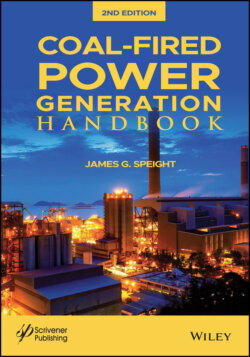Читать книгу Coal-Fired Power Generation Handbook - James Speight G., James G. Speight - Страница 70
3.5.2.3 Jig-Table Washing
ОглавлениеJig-table washing plants are so named because jigs are used to clean the >0.25 inch increment and Diester tables (oscillating table-sized sluices with a flat, riffled surface, approximately 12 feet square, which oscillates perpendicular to the riffles, in the direction of the flow of coal) are used to clean the <0.25 inch increment. Froth cells and/or thermal dryers may be used in conjunction with this equipment.
The raw coal, restricted to sizes smaller than eight inches, is separated on a wet screen (usually 0.25 inch mesh). The large-sized increment goes into the jig; the remaining coal is sent to a separate cleaning circuit. The coal is dewatered on screens and in centrifuges, crushed to the desired size, and loaded. The jig makes the equivalent gravity separation on the principles of settling in rising and falling currents. The small-sized coal (less than 1/4 inch) is combined with the proper amount of water and distributed to the tables, where the refuse is separated from the coal. The refuse is dewatered on a screen and discarded. The cleaned coal is dewatered on a sieve bend (a stationary gravity screen), where the extreme fines are removed and discharged into a centrifuge for final dewatering and removal of the fines. The cleaned coal (+28 meshes) is then loaded or conveyed to a thermal dryer where the heavy rejects are discharged off one end of the discharge side of the table. The light coal is discharged from the opposite end, and the middlings are distributed between.
